An interview with Jim Smith
Posted by the Node, on 3 August 2017
To interview Jim Smith I took a train to London and visited the Francis Crick Institute for the first time. The building had opened in 2016 and, by the time I visited, most if not all of the labs had settled in. Architecturally it was quite stunning, especially looking down from one of the higher floors and particularly so on a bright spring day. We sat down in one of the many open areas and chatted for an hour about Jim’s life and work both inside the lab and at the helm of large research institutions and funding agencies. I left thinking how positive it was for the field to have a developmental biologist with such energy and enthusiasm in such high places.
This interview by Aidan Maartens originally appeared in Development, Volume 143, Issue 15.
Jim Smith is Director of Science at the Wellcome Trust and a group leader at the Francis Crick Institute, where he was formerly Director of Research. A Fellow of both the Royal Society and the Academy of Medical Sciences, he was knighted for his services to medical research and science education in 2016. His lab works on mesoderm induction in the early vertebrate embryo. We met Jim in the Crick to hear about his life in science, his visions for the Crick and the Wellcome Trust, and his advice for early career scientists.
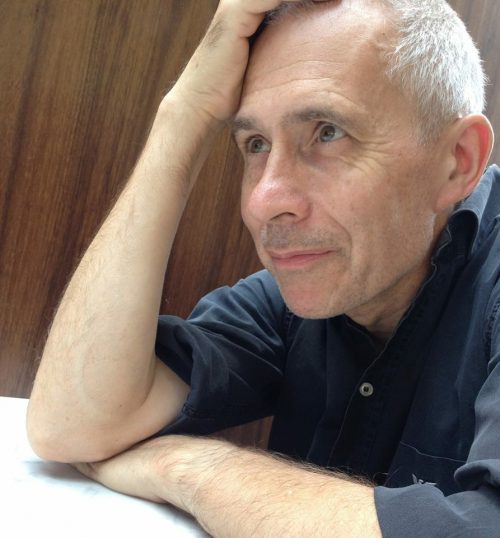
Let’s start with your first paper, which describes an investigation into the patterning of the chick limb from your PhD with Lewis Wolpert. How did this work come about?
When I went to university I was interested in maths, physics and chemistry, and at Cambridge you could do those three subjects without having to choose between them. But I had to do one more subject, and my director of studies convinced me to try biology, which I’d never done before because I’d done my O-levels a year early and there wasn’t time in the curriculum. So I gave it a go, and loved it. I was sent down the developmental biology pathway through lectures by John Gurdon and Peter Lawrence, and was introduced to Lewis Wolpert’s work by Peter. I joined Lewis’s lab to do a PhD at a very exciting time – they had just grafted mouse polarising regions into chicken limb buds and seen that you got duplicated limbs, which was a really dramatic illustration that there are universal molecular signals in limb development.
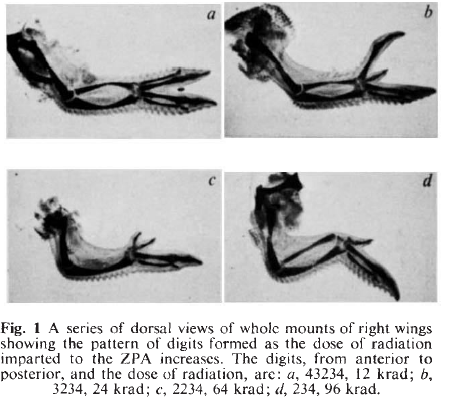
Now, that first paper – at the time I shared an office and a lab with Cheryll Tickle, and Lewis set me to work on the zone of polarising activity (ZPA), this special instructive region of the posterior part of the limb bud. Following on from wonderful work by Cheryll and Dennis Summerbell, the rationale for my experiments was to ask whether you needed cell division in order for the ZPA to influence development. So I irradiated these limb buds, first with X- and then γ-rays, and found that even without dividing the cells were still able to signal, but also that the more radiation you gave them, the weaker the signal was in terms of which extra digits it produced. At the time, I thought it was rather obvious and not was worth publishing or mentioning, but when Lewis heard about it he was much more interested and said we should write it up for Nature right away. Six weeks later, we had a thin envelope back saying it had been accepted – it was the easiest paper of my life, and it’s been downhill ever since.
And did you keep in touch with the limb field in your later career?
I did and I do, though of course there is so much literature to keep up with these days. I remember being at a meeting in Switzerland and bumping into Cliff Tabin, who took me somewhere – maybe his hotel room – and showed me the first in situ hybridisation data for Sonic Hedgehog. My mind was completely blown! In Lewis’s lab we had mapped out where the ZPA was by grafts and so on, we knew where it was at different stages, and these in situ data just overlapped perfectly. It was probably the most exciting thing I’ve ever seen – it was extraordinary.
After your PhD you went to Harvard for a short postdoc with Chuck Stiles – was this your first brush with growth factors?
Although I had always wanted to go to America, ending up with Chuck was a bit of an accident, but a happy one because I wanted to learn cell biology and biochemistry. Lewis’s lab was great to teach you to think, but (with all due respect) much of what you did was graft bits of tissue around, and I knew that to work out what the polarising signal was I’d need to know a little bit about cell biology and biochemistry. So in Chuck’s lab we did some stuff on the regulation of the cell cycle, and I learned cell culture and cell fusion. We discovered – in another paper that got published surprisingly easily – that growth factors remain active when stuck to substrates. But perhaps the most important thing was the recognition that growth factors might be important not only to make cells grow, but also for embryos and patterning as well. I published a paper in a supplement of the Journal of Embryology and Experimental Morphology (now Development) in 1981 called ‘Growth factors and pattern formation’, which was quite prescient I guess, though it remains relatively uncited. All this work got me thinking about how to assay for the activities of these factors in embryos.
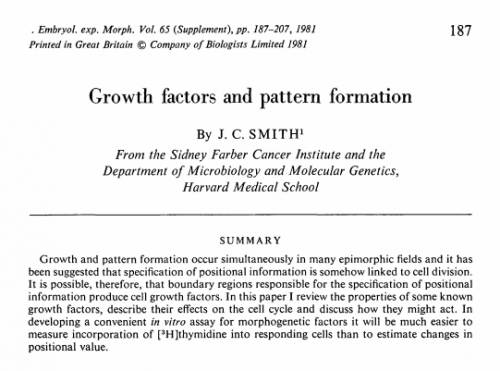
I enjoyed living in the States – I wish I had been able to stay there longer. I’d never had more disposable income in my life before, or indeed since – I remember going into record shops and just being able to buy whatever I wanted! Lab-wise, the differences were extraordinary. Lewis’s lab was on the top floor of the Windeyer building of the Middlesex Hospital Medical School, and it was really just an extended hut – if the weather was hot, you didn’t need to put the chicken embryos in an incubator because it went up to 38°C anyway. But this did illustrate to me that you can do great science, fun science, in an environment that might look unpromising. And Lewis was a fantastic supervisor – he kept out of the way when he had to, gave advice when it was necessary, and supported me and continues to support me today.
Back in England for a postdoc with Jonathan Slack, you started your career-long affiliation with Xenopus. What do you think of the state of Xenopus as a model, and its future?
Xenopus is a very powerful model organism that you can still do great work with, and I claim – and will fight anyone who disagrees with me – that we have learned more about the generalisable aspects of early vertebrate development from Xenopus than from any other species. But I do think that people worry too much about model organisms, and Xenopus people are no exception in being defensive over their model. In an ideal world, you would work on a model that best allowed you to answer the question you are interested in. The trouble is that it takes a certain amount of investment and infrastructure to work on any model, which raises the activation energy for shifting to another. This means it’s very helpful to work in an environment that has as many organisms around as possible, which was what we had at Mill Hill in the nineties. If we had a problem that would be better approached in another animal, we’d just go and collaborate. The Crick will I hope foster the same sorts of collaborations, but also beyond developmental biology.
First with Jonathan Slack and then in your own lab at Mill Hill, you helped to identify the molecules responsible for induction of the mesoderm, and later the transcriptional networks these molecules regulated. What are the key open questions in how mesoderm induction works today?
The way I like to think about it is reflected in the title of a talk I gave recently – ‘The first ten hours in the life of a frog’. Mesoderm induction happens during those first ten hours or so, and it’s becoming clear that everything in this time is coordinated and interdependent, so if you want to understand mesoderm induction you cannot look at it in isolation. You have to look at it in terms of fertilisation, chromatin structure and dynamics, the early activation of transcription and transcription factor cascades, and the cell cycle, which we are working on quite a lot at the moment and which is proving to be very interesting. And intercellular signalling – we still don’t quite know how signals travel between cells, the details of how the signal transduction pathways activate the genes, or how the different pathways interact with each other. We don’t really understand the cell movements, why it is that particular cells move earlier than others, and why they move where they move. There’s still so much to find out, and it will certainly see me out as a problem.
If you want to understand mesoderm induction you cannot look at it in isolation
And where do you think developmental biology as a field is going?
I think we’re getting down to a deeper understanding of the spatial and temporal aspects of development. What I’d like to do is to develop simple real-time in situ hybridisation, to watch genes turning on and off in real time in a living embryo – not snapshots of fixed embryos. If you just watch things happen, you’ll get a really good idea of the dynamics of the processes. I think what it comes down to is technology – a lot of what we do will be driven by new advances. As new technologies come along, we’ll be able to ask new questions, some of which we can’t conceive of at the moment. Technology is highly under-rated: as I think Mike Levine said in a previous Development interview, the low-hanging fruit in developmental biology has been hoovered up mercilessly by the old farts – my generation – and we were very lucky. The future will lie in the ability to ask new questions with new technologies.
As well as a productive research career, you have held top administrative jobs throughout your career. As head of the National Institute for Medical Research (NIMR), you were involved in the development of The Francis Crick Institute, where you were Director of Research and where your lab is now based. What was the extent of your involvement, and, a few months in, is it too early to say whether the initial aims are being met?
I think it might be helpful to go back and ask why I do these leadership jobs in the first place. One of the things about early scientific success, which I was fortunate enough to have, is that people think you will be good at other things besides being good at science. So people ask you to do stuff, and if you’re not strong enough, as I wasn’t, you just say yes, and end up wrapped up into these leadership positions. Not that I’m complaining, you understand!
So I went to the Gurdon Institute to be Director from 2000 to 2008, and that was a very valuable experience. It was a small-ish place with terrific, collegial people working there, who made it very easy to do my job. And then I moved back to the NIMR as director, having worked there previously for 16 years from 1984. Coming back, it was a torrid time for the institute, because its members did not know what was going to happen to it and were very anxious as a result. We were aware that there would be this thing into which NIMR would move, and as the idea took shape, it was my job to shepherd NIMR into this new world. It was an interesting and fun task to work together to get the momentum and enthusiasm going for the move. By this time, Paul Nurse (then at The Rockefeller University), Richard Treisman (then Director of the CRUK London Research Institute) and I were working together quite closely on this, and we made sure, I hope, that everyone in the two founding institutes played as much of a part as they could in the design of the building and the way it would work. In designing an institute, the building itself is important, but just as important, or more so, are the people you bring in and the mindset that they bring in with them.
Richard and I spent a lot of time on building design, with a great deal of help from Steve Gamblin and John Diffley, and with the architects of course, and together designed the layout you can see today. The building’s lines of sight, its break-out areas, its central staircase, all reflect our aim for a design that would encourage people who work on different things to meet, interact, and talk with each other. And is it working? It’s been about six months, and the answer I think is yes – people seem to be happy and to like the building. I hope the mix of people we’ve brought together will mean we’ll have more collaborations than we had at the two founding institutes.
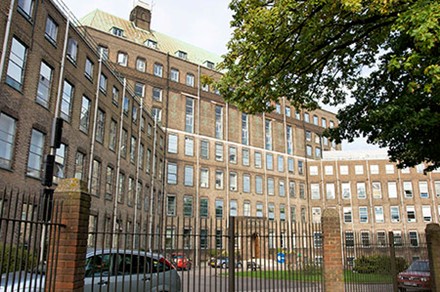
Was it hard to say goodbye to Mill Hill?
Well, of course I was sorry to leave – I had known the place for a third of a century, and I’d done my best work there, for sure. It was a quirky building in a quirky place, miles from anywhere – but it worked, and people loved it. It was a real wrench for many people to leave, but as this all coincided with its centenary, we had some really fantastic send-off parties! One hopes that the spirit and the collaborations will happen here as they happened there.
Your recently took up your job as Director of Science at the Wellcome Trust. What do you hope to achieve there?
Well, it’s quite a long list. First, I want to make sure that we fund the best science, and keep science at the centre of everything Wellcome does. We need to make sure the people we fund are supported properly, regardless of where in the country they work, and irrespective of their gender, social background, sexual preference, disability or religion. We have a drive at Wellcome focussing on inclusion and diversity, led by Lauren Couch, and that’s really important to me. We know for instance that 50% of graduate students in biomedical sciences are women, for example, but once you get to my exalted heights it’s something like 16% – we are losing some of our best scientists for no other reason than that they are women, and we have to stop that.
Second, I want to make sure that science is an attractive career with an appropriate career structure. We need to make sure that people are trained – for example in data science and statistics – at the right stages of their careers so that they have the best chance to advance. It’s also important that molecular biologists are aware of clinical medicine, and that people understand how pharmaceutical companies work, and how things operate in government. This will be crucial – not least because we need more people with a scientific background moving in to areas like law or journalism or government.
Third, while of course I want to emphasise and support basic science, it’s also important that when a basic scientist does something that can be translated, it is translated, and Wellcome’s Innovations division led by Steve Caddick can help with this. Everything depends on basic science but you can’t just do basic science and ignore the translation. It behoves people like me particularly to make sure that translation happens.
Fourth, I think it’s important to make sure that the UK is a good place to do science. At Wellcome, Simon Chaplin leads the Culture and Society division, which helps ensure that science is recognised and celebrated as being the best way to understand the way the world works, and to integrate science into our everyday lives.
It’s a lot, what I’ve just described – basic science, the right facilities, equality, infrastructure, careers, translation, research culture – but I think all these aims tie together.
Everything depends on basic science but you can’t just do basic science and ignore the translation
How do you see the prospects for funding of basic versus applied research in this country?
I’ve been Deputy Chief Executive at the Medical Research Council, and am now Director of Science at the Wellcome Trust, and when I speak to people in high office there is a clear understanding, belief and acceptance that basic science is the only way to go. But, as I touched on earlier, there is also the expectation that the basic science will be translated. Scientists cannot simply work in their basic science bubble – it’s important, as well as interesting and fun, to be around clinicians, chemists, pharmaceutical companies. As an example, the Crick has a fantastic interaction with GlaxoSmithKline that is not only advancing our understanding of particular problems, but also advancing our understanding of the environment in which both kinds of science work. This breaks down the illusion that they are different kinds of science – we are all in the end trying to work out how life works and how to make the world better, and the more you put people in bubbles, the worse off they will be. I do feel quite strongly about this.
How will institutions like the Wellcome Trust and the Crick adapt once Britain has left the European Union?
Both organisations are in a privileged position because people listen to us; for instance, Paul Nurse has been very visible in the debate about the effect of Brexit on science. In the immediate term, we care about our staff: in the Crick, about 30% of total staff and 56% of postdocs are from non-UK EU countries – we need to establish their right to remain in the UK. The postdoc stage is a very mobile time in your career: all of a sudden, young researchers go all over the world, and very frequently return to their home countries. That experience is incredibly valuable both to the country that sends them out and the country that receives them. So we are working hard to ensure that any migration system after Brexit should recognise that the UK in general, like the Crick, will benefit hugely from international researchers. I think that we should use Brexit to introduce a more streamlined system to cover all highly skilled research staff, whether EU or non-EU, and in particular we need to help people early in their careers to come to the UK – this has been difficult because the immigration system uses salary as a measure of seniority and skills, but postdoc salaries aren’t always enough to qualify them. And then of course there is the funding – access to EU funding and the European Research Council framework has been very valuable, if occasionally bureaucratic – and conversations are currently under way as to how we’ll maintain access to this.
You have a long history with Development, first publishing with us in 1979, and taking the reins from Chris Wylie to be our Editor-in-Chief from 2003 to 2009. How did the journal change during your tenure, and where do you see the journal’s present and future?
I looked it up – I think I’ve published 68 papers in Development, so it’s probably my main journal. Chris made some huge changes to the journal, turning it upside down, and Development is still his journal really: he gave us the structure, the format, the look. When I came in I saw my main job as not screwing up what Chris had done! With Jane Alfred, who joined as Executive Editor during my tenure and with whom I worked very well, we did make a few changes. It was stem cell time, or as Doug Melton and I both like to call it, ‘applied developmental biology’, so we got Ken Chien, Ken Zaret and Austin Smith in as editors. We introduced the ‘Research reports’ section, and I was keen to make sure that the review process was quick and decisive. I also wanted to make sure the papers were interesting – for a while there were too many papers with a generic title such as ‘The role of gene X in organ Y in species Z’, and I didn’t like that sort of title; we tried to make them more question-driven. I think we also had the initial discussions for Development’s community blog, the Node, and I’m quite proud of that even though I didn’t take it forward personally.
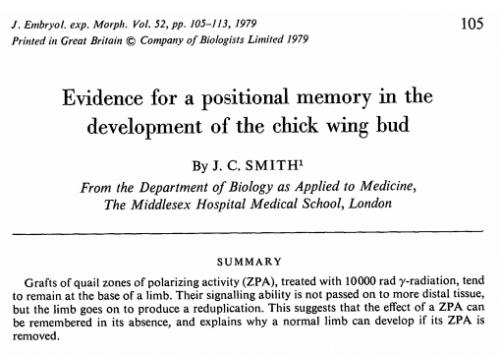
As for the future – I am quite taken by preprints, and I think Development’s two-way integration with bioRxiv is terrific. I am also keen on the Wellcome Open Research journal, and the planned Gates Open Research, both using the F1000 publishing platform – they’re interesting models to keep an eye on. We’re at quite an interesting time where we’re circling around trying to decide what the best way forward is for publishing.
And this year you were knighted – congratulations! What does the recognition mean to you?
Well it was fantastic for the field – with Ottoline [Leyser], Mandy [Amanda Fisher] and me all being recognised in one go. But yes of course I was pleased, and proud I suppose – I wished my parents were still alive to see it. I guess it sounds kind of hokey but it makes you think about all the people that work and have worked with you, the postdocs and students without whom I couldn’t have achieved much. I’ve been tremendously lucky in having great people in my lab, many of whom have become firm friends – part of the fun of doing science is that you meet people and make friends. The knighthood’s a hoot – my kids love it, I love it, but you can still call me Jim!
Do you have any advice for young scientists today?
I’ll repeat what I said earlier: if you can become expert in a technology it is not going to do you any harm at all. Enjoy yourself, remember how lucky you are to be doing what you’re doing, be generous with reagents and data, and magnanimous about authorship where necessary. The truth will always out, and the minuscule risk of sharing stuff and being scooped is far outweighed by the opportunities that will come along and the friends you will make – as I’ve said, one of the best things about science is the friendships you make along the way. But most importantly, I’d say to take your career into your own hands. Far too many people are passive in their careers, and wait for stuff to happen to them, but if you just sit back and wait, it won’t happen. Other people won’t do it for you.
Is there anything that Development readers would be surprised to find out about you?
Well I was thinking about this – I don’t think so, actually. Thanks to Twitter, I’m probably an open book – so people can find out anything about me, whether it’s the music I like or my love for running, by following me @ProfJimSmith.






 (No Ratings Yet)
(No Ratings Yet)
Congratulations, Jim, on being recognized for all the great work you’ve done. I very much enjoyed this interview. Alas, I yearn for the day when the U.S. will learn to lionize our most esteemed basic scientists.